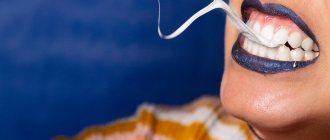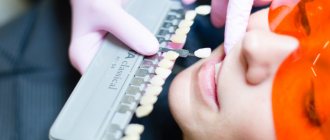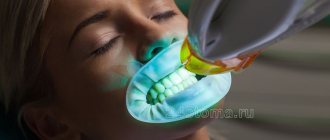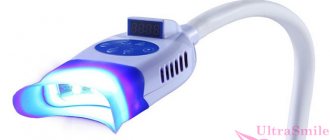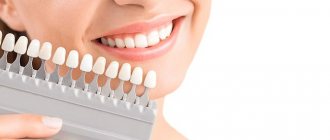Types of professional teeth whitening
Reviews about types of teeth whitening on the Internet make many patients believe in the myth about the effectiveness of hydrogen peroxide purchased at the pharmacy, soda, activated carbon and other simple methods. Following such dubious advice is not only pointless, but also fraught with dangerous consequences - burns of the oral cavity, damage to the enamel and increased sensitivity of the teeth. In fact, there are only two types of professional whitening – in-office and at-home.
In-office bleaching
This term in dentistry means teeth whitening under the supervision of a doctor using gels based on hydrogen peroxide or urea, as well as catalysts in the form of ultraviolet light or a laser beam. The chemical composition affects only 20% of the organic substances contained in hard dental tissue (dentine) and does not cause any harm to the teeth. The final result of the procedure depends on the initial shade of the teeth, determined according to the VITA scale. In most cases, it is possible to achieve a lightening of 5 to 10 tones. Let's look at the features of each type of teeth whitening in the clinic.
Photobleaching
During photo-whitening, the whitening gel is applied to the tooth surface from the front. The action of the product is accelerated by a lamp with ultraviolet radiation. One session lasts 15 – 30 minutes. The maximum change in tooth shade is possible by 8 – 10 tones. The cost of the service is about 10,000 rubles.
Laser whitening
The reagent on the teeth is catalyzed by a laser beam rather than an ultraviolet lamp. Each tooth is processed separately. In one laser whitening procedure, you can improve your color by 12 shades. The price of an effective technique is proportionally high - from 20,000 rubles per session.
Chemical bleaching
In chemical whitening, a whitening gel is applied to the surface of the teeth, and no ultraviolet light or laser is used. The method is gentle, so teeth become whiter by only 5 to 7 tones. The cost of the procedure is about 12,000 rubles.
In-canal whitening
It is used when the tooth has darkened due to filling the canals with coloring materials. The dentist drills a hole in the tooth cavity, applies a brightening agent and places a temporary filling. After achieving the desired result, the final restoration of the tooth is carried out. Endo-whitening costs approximately 1,000 rubles per tooth.
Contrary to what many patients believe, the popular Air Flow procedure involves mechanical cleaning and not teeth whitening. A powerful stream of air, water, soda and other components removes bacterial and hard plaque, polishing and leveling the tooth surface. After the session, the teeth visually become whiter because they have been cleaned of impurities and returned to their natural color. The same can be said about ultrasonic whitening.
When to whiten teeth: before or after implantation?
Dentists, before installing fixed dentures or implanting an artificial root, always recommend teeth whitening, and there are two reasons for this.
Dental plaque and tartar harbor harmful bacteria. If both are not removed, these bacteria can penetrate the bone tissue during drilling for the implant and later cause an inflammatory process there.
It is also important that after teeth whitening, the dentist will be able to choose the right color for the crowns so that they do not stand out against the background of the dentition.
Home whitening
The method is suitable for those who want to whiten their teeth without risk to health and save a lot of money. However, before using whitening at home, it is recommended to consult a dentist to avoid mistakes when choosing the appropriate product and in the process of using it.
Home whitening systems with trays
Gel with individual trays for home whitening is issued in dentists after consultation with a doctor. Simpler sets with standard mouth guards can be purchased at the pharmacy. Due to the low concentration of hydrogen peroxide or urea in the gel, teeth are lightened by 5 to 8 tones. The price of the set varies from 2,000 to 7,000 rubles. The cost of making an individual mouthguard will be about 6,000 rubles.
Stripes
The devices contain a gel with a small content of hydrogen peroxide. The strips are applied to the teeth for about 30 minutes for a month. The effect is lightening by 3 – 5 tones. The cost of the kit is from 1,000 to 4,000 rubles. Perhaps the most effective means of this type will be Crest strips.
Gels and varnishes
The teeth are coated with a whitening agent with remineralizing components using a brush or brush. As a rule, the solution does not require rinsing and is used regularly for two weeks. Teeth become 1–2 shades whiter. Purchase costs will range from 300 to 1,000 rubles. One example of such products is the Blanx whitening pencil.
Whitening pastes
Toothpastes, rinses, brushes and flosses with a whitening effect in rare cases “increase” whiteness by a maximum of 1 tone. Experts recommend using such products to maintain the results of professional whitening. The simplest whitening paste can be bought at an affordable price - from 150 rubles. Low-abrasion toothpaste with a brightening effect, Extreme Whitening Swissdent, will cost more.
How to care for whitened teeth?
Immediately after the whitening procedure, for 2-3 days it is better to refrain from coloring products - wine, berry jam, strong tea (especially cheap... from bags in which nothing but paint is poured, not even tea leaves), coffee, smoking (if possible ) and so on. If increased sensitivity occurs after the procedure, you can use a special paste for sensitive teeth (Lacalute Sensitive, Sensodyne) or ask your dentist for a special gel to reduce sensitivity, which often comes in the same set with a whitening gel. In the future, no specific care for whitened teeth is required. Over time, their natural color will be restored. In this case, you can conduct a short maintenance course of home whitening, after consulting with your dentist. Typically, such a need arises no more often than every 6 months to 1 year.
Pros and cons of types of teeth whitening
Photobleaching
- Instant results.
- Uniform impact.
- The duration of the session is no more than an hour.
- Whitening by 8 – 10 tones.
- The occurrence of tooth sensitivity during and after the procedure.
Laser whitening
- Instant results.
- No discomfort during the procedure.
- Maintaining the acid balance of the oral cavity.
- Strengthening enamel.
- Whitening by 12 tones.
- The duration of the session is more than an hour.
- Uneven teeth whitening.
- High price.
Chemical bleaching
- Instant results.
- Uniform impact.
- Acceptable price.
- Simplicity of the procedure.
- Whitening by 5 – 7 tones.
- The occurrence of tooth sensitivity during and after the procedure.
- The need for several sessions.
In-canal whitening
- Local effect on tissue.
- Painless.
- Whitening by 5 – 7 tones.
- Weakening of dental tissues.
- Prohibition on repeating the procedure.
Whitening on trays
- Affordable price.
- Possibility to use the mouth guard at any time.
- Whitening by 5 – 8 tones.
- The duration of the course is 1 month.
Lightening strips
- Visible effect after the third application.
- Affordable price.
- Whitening by 3 – 5 tones.
- Inconvenient to use.
- The duration of the course is 1 month.
Varnish or pencil
- Ease of use.
- Minimum costs.
- Lightening by 1 - 2 tones.
- Poor efficiency.
Best Teeth Whitening Products
Apples and pears
These fruits contain malic acid, which, by the way, is used to create toothpaste.
When faced with dark plaque, the acid dissolves it and serves as a natural scrub for tooth enamel .
Keep in mind! Ripe fruits also provide massage to the gums when chewed, which helps strengthen them.
To achieve the desired effect, you only need to eat one small fruit after each meal.
Some people rub a piece of apple onto the enamel, and this method will also work, but you should be careful here and avoid irritating your gums.
Strawberry
Despite their bright color, strawberries are an excellent natural brightener.
It also contains malic acid, which discolors dark plaque on the teeth.
The acid also works as a disinfectant, has a positive effect on the health of the entire oral cavity and prevents bacteria from multiplying.
For the desired effect, it is enough to eat a small handful of fresh ripe strawberries several times a week .
Seeds and nuts
Note! Fresh nuts and seeds serve as a natural enamel cleaner, gently polishing it and removing dark stains from the surface of the teeth.
Not to be confused with roasted nuts. Beneficial components are transformed into harmful ones during the frying process, and the effect will be the opposite.
Three times a week it is enough to eat 10 nuts or 80 g of sunflower seeds.
Onion
Everyone knows the pungent odor from the mouth after a salad with the addition of fresh onions, which we are so eager to get rid of.
However, onions have a positive effect not only on general immunity, but also on oral health.
Eating onions provokes active production of saliva, which has a beneficial effect on oral hygiene .
It is not necessary to specifically eat a whole onion; just add fresh onion rings to vegetable salads.
Carrot
It is worth noting! Eating fresh carrots helps remove pieces of food stuck between the teeth and stimulates the proper functioning of the salivary glands.
Carrots contain calcium necessary for teeth and carotene, which is beneficial for gums.
A pureed vegetable copes with these tasks worse, but 100 g of fresh and raw carrots will benefit the oral cavity and the entire body as a whole.
Orange
Citrus fruits are a huge source of vitamins and microelements.
The orange contains ascorbic, citric and pectic acids, but there is no fat or dyes at all.
After just a few orange slices you can feel the freshness in your mouth . The fruit is also added to salads or drinking water.
Celery
In addition to the fact that celery has a negative calorie content, it also copes with dental plaque and pathogenic bacteria.
Need to know! When consuming celery, saliva is released abundantly, which helps maintain oral hygiene.
It is recommended to make juice based on celery and drink 100 ml before meals.
Broccoli
The raw crispy vegetable gently polishes teeth and restores natural whiteness , and also eliminates bad breath.
According to some European studies, regular consumption of broccoli even prevents the formation of tooth decay.
It is believed that the elements contained in the vegetable cope well with harmful acids, which cause this unpleasant disease.
You can get a noticeable effect by eating just one inflorescence.
Hard cheese
For your information! A small piece of hard cheese is enough to maintain the balance of essential microelements in the body and clean the surface of the teeth from dark plaque.
Cheese also contains calcium, phosphorus and proteins necessary for tooth enamel.
Baking soda
Soda is a chemically active substance and, perhaps, the most famous folk remedy for getting a snow-white smile .
There are many recipes and methods of use.
The simplest: add 2 teaspoons of soda to 100 ml of water, cooled to room temperature, and dip your toothbrush in this solution before use.
They note that the effect is noticeable after the first use . But do not forget about precautions: you need to brush your teeth with a soda solution no more than once a week.
Parsley and cilantro
This green contains ingredients that help destroy dental plaque and coloring pigments.
Know! Thus, if you regularly add parsley or cilantro to salads, soups, and other dishes, you can keep your teeth clean and prevent serious diseases.
Dairy
Fresh, natural, sugar-free dairy products help strengthen teeth and maintain their healthy color .
Milk, kefir and yogurt contain many beneficial substances, including calcium and lactic acid.
It is enough to drink one glass every day to evaluate the whitening effect and protect your teeth from decay.
Herb tea
Herbal tea does not contain harmful caffeine, does not stain teeth, but cleanses them.
In addition, it is rich in vitamins and minerals, preventing dehydration and any inflammatory processes in the mouth.
Note! The whitening effect will be noticeable if you completely replace strong coffee with herbal tea and drink it several times a day.
Water
The easiest way to maintain the natural whiteness of your teeth is to drink more clean water .
It cleanses the oral cavity of stuck pieces of food , which then become food for bacteria.
After drinking coloring drinks, water washes away the pigment that causes darkening of teeth.
However, you should avoid carbonated water; it has a negative effect on the enamel.


